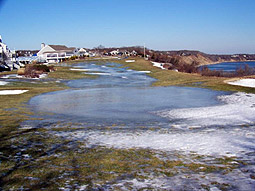An Old Fashioned Winter
February 3, 2009
The abnormally cold January weather has resulted in an old-fashioned winter of sorts. While the cold temperatures have created a winter wonderland in the northern interior sections of the region, those along the coast have experienced a wider range of weather events that have led to multiple freezing and thawing, and significant accumulations of ice. The weather ahead promises to bring more snow, rain, and mixed precipitation that should keep things interesting.
 |
|
 |
|
| Heavy rains, followed by freezing temperatures along coastal Massachusetts has encased greens and other playing surfaces in a potentially damaging layer of ice. |
Superintendents with thick ice accumulations across their golf course are in a quandary as to what to do with the ice layer with the midway point of winter approaching. Here are a few questions that you may find helpful while making the all important decisions.
- How long has the ice layer been in place? The duration of ice cover can be a concern, especially on poorly-drained, soil- based greens dominated by annual bluegrass. However, even annual bluegrass can generally tolerate three weeks of ice cover before any action is taken.
- Have you examined beneath the ice cover? Although difficult, it is possible to saw or chisel through an ice layer to sample for anoxic conditions. The anaerobic smell is a telltale sign of potential problems and the need to take action. Pull a sample turf plug while you are at it to check for the turf's survival. Bring the turf plug indoors to allow the grass to resume growth. You might find that the plug already shows significant damage, in which case immediate ice removal is less critical.
- Is there an insulating snow cover over the ice? A nice layer of snow is an excellent insulating blanket that can offer protection from cold temperatures. In contrast, an exposed layer of ice is not. Keep the snow in place at least until temperatures moderate.
- What is the long range weather forecast? Long range forecast may not always be right, but they should be considered when formulating plans to expose and remove ice. Always work with the weather whenever possible. That is, wait until temperatures climb near or above freezing and night time low temperatures will not be extreme. It will make the removal process easier and less damaging, and there will less concern with the turf exposed to lethal cold temperatures.
- Do you have adequate resources to complete the major task ahead of you? Removing snow and ice layers from the putting greens requires snow blowers, plenty of manual labor, and melting agents. Do you have the means to carry out the extensive operation or will additional staff have to be called back in. Perhaps your efforts will be better spent targeting low pockets and other problem areas to assure that water can move from the greens when a natural thawing process occurs.
Unfortunately, there are no sure answers as to what should be done with ice layers. So much depends on weather conditions before, during, and immediately following the ice removal. It is important to remember that ice related damage probably occurs more often as result of the initial freezing action and formation of ice crystals in the plant and not the duration of ice cover. Pulling turf samples periodically from ice covered greens will help determine if the damage has already taken place and more importantly will further justify your management decisions.
Contact Dave Oatis, Adam Moeller or me if you are concerned about the winter conditions or are contemplating taking action. For those of you traveling to the Golf Industry Show, stop-by the Green Section booth in New Orleans where we will be happy to discuss this good old-fashioned winter and any other turf topics at hand.
Northeast Region Green Section- Dave Oatis, Director doatis@usga.org ; Adam Moeller, Agronomist amoeller@usga.org ; Jim Skorulski, Senior Agronomist jskorulski@usga.org.
